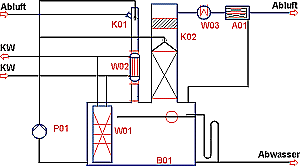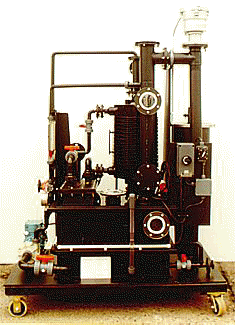to range of washers |
| Products - Washer programme |
|
|
A new unit-construction system for laboratory gas washers also for use in an extreme environment |
|
Laboratory gas washers: |
|
|

Figure 1
B01 Storage tank
W01 Circiut water cooler
K01 Jet gas washer
K02 Packed column |
W02 Waste gas cooler
W03 Heating
P01 Circuit pump
A01 Ringsorber |
|
Laboratory gas washer DGE-LGW |
|
| Laboratory gas washers represent
washing systems developed to purify small flow-rates of air with
a low content of harmful substances. Although it is a case of a
treating only a negligible flow-rate of waste air it is necessary
also at realizing this washing system to separate harmful substances
from the drawn off waste air. The firm DGE GmbH has classified the
existing design group of laboratory gas washers in two different
design groups and they have been revised in principle :
-
stationary Laboratory
gas washer
- mobile
Laboratory gas washer
|
|
|
There are the following standard subassemblies for using DGE-Laboratory gas washers for exhaust air purification: |
|
Subassembly |
DN |
DN |
D |
D |
FKW |
SSW |
Exhaust air flow |
| D |
D |
D |
m³/h |
|
| DGE
- LGW |
125 |
60 |
10 - 35 |
| DGE
- LGW |
150 |
80 |
20 - 65 |
| DGE
- LGW |
200 |
100 |
40 - 100 |
| DGE
- LGW |
300 |
150 |
80 - 250 |
|
|
| At dimensioning the laboratory gas washers three standard construction units have been used: self-suction jet gas washers (SSW), washers filled with small solid bodies (FKW) and circular absorbers (RGAD). In Figure 1 it is presented the basic flow sheet serving for installing the laboratory gas washer designed to serve for
purifying the acid drawn off waste air which is contaminated also by organic compounds. The drawn off waste air which has to be purified is sucked through a self-suction jet washer and the flow of the drawn off waste air is cooled subsequently in a heat exchanger. The separation of acid components takes place in a jet gas washer and in a washer filled with small solid bodies which is in operation with the use of water in a closed circuit. The heat exchanger necessary for cooling washing water is installed in the storage tank and it does not require any other additional place for installing. Components which can not be separated by washing are desorbed in a circular adsorber which is installed subsequently in series. The circular adsorber is fitted with a replaceable activated carbon cartridge. |
|
| Always it is possible to adapt the design of stationary laboratory gas washer to appropriate local conditions. For a mobile utilization of that unit the firm DGE GmbH has developed a mobile system by means of which it is possible to change easy the place of utilization of this gas washer . |
The complete
laboratory gas washer is made of a conductive plastics and it
is installed on a mobile basic frame. In Figure 2 aside it is
illustrated a compact construction of this system. This system
is appropriate particularly for purifying waste air the drawn
off from batch processes realized in different points as usual
in laboratories and appropriate pilot plants.
It has been realized also a different execution of these laboratory gas washers as for example as made of high-grade steel. The use of an appropriate material is always dependent on a concrete job specification.
|
Fig. 2  |
|
|
|
to range of washersrs
|

